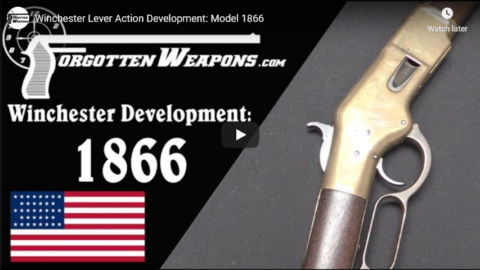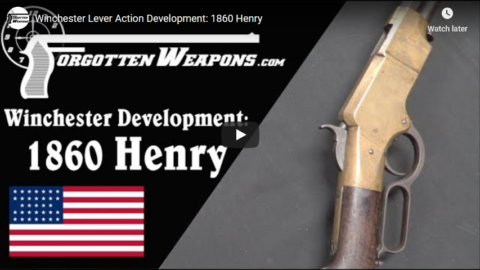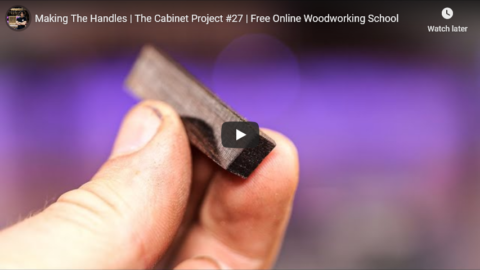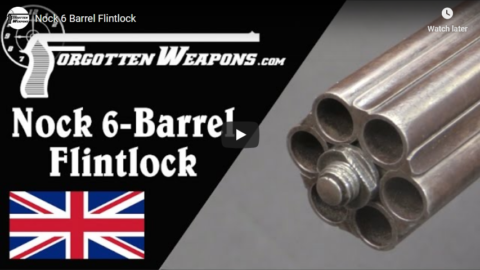Forgotten Weapons
Published 7 Jun 2017While the Henry Repeating Rifle had been an serious leap forward in firearms capability, it was not without problems. The biggest single weakness of the Henry was its magazine. The tube magazine was open to dirt and debris, the follower could easily come to rest on the shooter’s hand or anything used as a rest and stop the weapon from feeding, and the while system was rather prone to being damaged.
These problems would all be addressed with the addition of Nelson King’s new loading gate idea, which allowed Winchester to omit the exposed follower entirely, solving a bunch of complaints all at once. The new system was more durable, more reliable, and allowed the rifle to be loaded without the awkward manipulation required by the Henry. The King improvement also allowed the addition of a wooden handguard, which was a welcome addition — it does not take very many black powder rounds for a barrel to become uncomfortably hot to the touch.
At the same time that these improvements were being made, company politics were taking shape to end Benjamin T. Henry’s involvement with the company. Henry attempted to take over ownership of the company because he felt he was not profiting as much as he should, but he had assigned his patent rights to Oliver Winchester in exchange for his contract to manufacture the guns. As a result, Winchester was able to create a new company (the Winchester Repeating Arms Company) with full rights to the design patents and sideline Henry.
The 1866 rifle, which was formally called simply the Winchester Repeating Rifle would continue to use the .44 Henry Rimfire cartridge, but would be made in a wider variety of configurations than the Henry had been, including carbine, rifle, and musket barrel lengths. It would prove to be a very popular rifle, and opened the path to further improvement, as it put the Winchester company on excellent financial footing.
Cool Forgotten Weapons merchandise! http://shop.bbtv.com/collections/forg…
http://www.patreon.com/ForgottenWeapons
If you enjoy Forgotten Weapons, check out its sister channel, InRangeTV! http://www.youtube.com/InRangeTVShow
October 5, 2020
Winchester Lever Action Development: Model 1866
October 2, 2020
Winchester Lever Action Development: 1860 Henry
Forgotten Weapons
Published 5 Jun 2017The Henry Repeating Rifle was a truly revolutionary development in firearms technology. It was not the first repeating rifle, but it was the best of a emerging class of new arms, reliable in function and very fast to shoot (much faster than the contemporary Spencers). The Henry used a simple toggle lock locking system, with a single throw of its lever performing all the elements necessary to reload and recock the action.
The Henry’s quick action was coupled with a 15-round magazine, more than double what the Spencer offered. It fired the .44 Henry rimfire cartridge, which threw a 216 grain bullet at about 1125 feet per second (this would change to 200 grains at 1200 fps within a few years). This was substantially less powerful than a heavy muzzleloader charge, but the volume of fire more than made up for it. Within 200 yards, the Henry could produce a devastating volume of fire.
The Henry was only produced for about 5 years (1862 – 1866), with about 12,000 manufactured in total. The Henry was made almost exclusively in a standard rifle pattern, with a 24 inch barrel. Some were later cut down into carbines, though. While the US military rejected the Henry for a variety of reasons, nearly all of the guns produced before the end of the war did actually see military service, with state units or individuals who supplied their own arms. In the few engagements where Henry rifles were present in substantial numbers, they proved to be a significant force multiplier.
Cool Forgotten Weapons merchandise! http://shop.bbtv.com/collections/forg…
http://www.patreon.com/ForgottenWeapons
If you enjoy Forgotten Weapons, check out its sister channel, InRangeTV! http://www.youtube.com/InRangeTVShow
September 26, 2020
Perdition to Conspirators! Magnificent 14-Barrel Flintlock
Forgotten Weapons
Published 29 May 2020http://www.patreon.com/ForgottenWeapons
https://www.floatplane.com/channel/Fo…
Cool Forgotten Weapons merch! http://shop.bbtv.com/collections/forg…
Colonel Thomas Thornton was a wealthy and somewhat flamboyant character in England in the late 18th and early 19th century. He commanded a militia unit with which he had some disagreement, and which mutinied against his comment at Roborough Camp in 1795. Some years later, he commissioned this quite unique firearm from Dupe & Company of London.
The gun is a single stock with two flintlock actions, two triggers, and two clusters of seven .30 caliber rifled barrels each. Each trigger fires a complete barrel cluster simultaneously. In addition to the firepower of this very remarkable weapon, he also had it finished in a truly magnificent fashion, including the fantastic line “PERDITION TO CONSPIRATORS” on ons of the barrel clusters — clearly he harbored some resentment towards his unruly militia subordinates even years later.
In addition, he had a second stock made to fit just one lock plate and barrel cluster, for when 14 barrels might be a bit of overkill. That stock is even more decorated that the first, with beautiful wooden relief carvings and the motto “A Verite Gagner“, meaning something to the effect of “Truth From Victory”.
This gun is part of the Liege arms museum’s display of civilian arms, and I’d like to thank them for taking it out of their display so I could show it to you! If you are in Liege, stop in and see the museum:
Contact:
Forgotten Weapons
6281 N. Oracle #36270
Tucson, AZ 85740
September 23, 2020
Tank Chats #80 Black Prince | The Tank Museum
The Tank Museum
Published 12 Jul 2019The Tank Museum has the only surviving example of the Second World War prototype tank, the A43 Black Prince. The designers of the Churchill tank were commissioned to build a tank which could hold the larger 17 pounder gun. The Centurion was chosen to go into production instead of the Black Prince, due to its superior engine and armour.
Support the work of The Tank Museum on Patreon: ► https://www.patreon.com/tankmuseum
Visit The Tank Museum SHOP: ► https://tankmuseumshop.org/
Twitter: ► https://twitter.com/TankMuseum
Instagram: ► https://www.instagram.com/tankmuseum/
Tiger Tank Blog: ► http://blog.tiger-tank.com/
Tank 100 First World War Centenary Blog: ► http://tank100.com/ #tankmuseum #tanks #tankchats
September 22, 2020
Making The Handles | The Cabinet Project #27 | Free Online Woodworking School
Matt Estlea
Published 16 Sep 2020In this video, I show you how to design and make the handles for the cabinet.
_________________________________________________________________Support what I do by becoming a Patron! This will help fund new tools, equipment and cover my overheads. Meaning I can continue to bring you regular, high quality, free content. Thank you so much for your support! https://www.patreon.com/mattestlea
Don’t want to commit to a monthly direct debit but still want to help out? That’s fine!
You can make a one time donation here: www.mattestlea.com/donate
You can donate us biscuits here: www.mattestlea.com/wishlist
_________________________________________________________________
BUY THE WOODWORKING BIBLE HERE:
www.mattestlea.com/the-woodworkers-manual
_________________________________________________________________SOCIAL MEDIA
Instagram: www.instagram.com/mattestlea
Twitter: www.twitter.com/mattestlea
Patreon: www.patreon.com/mattestlea
Pinterest: www.pinterest.com/mattestlea
LinkedIn: www.linkedin.com/in/matt-estlea-b6414b11a/
_________________________________________________________________
See what tools I use here: www.mattestlea.com/equipment
My Website: www.mattestlea.com
_________________________________________________________________My name is Matt Estlea, I’m a 24 year old Woodworker from Basingstoke in England and my aim is to make your woodworking less s***.
I come from 5 years tuition at Rycotewood Furniture Centre with a further 1 year working as an Artist in Residence at the Sylva Foundation. I now teach City and Guilds Furniture Making at Rycotewood as of September 2018.
If you’re interested in studying at Rycotewood, view their courses here:
www.mattestlea.com/rycotewoodI also had 5 years of experience working at Axminster Tools and Machinery where I helped customers with purchasing tools, demonstrated in stores and events, and gained extensive knowledge about a variety of tools and brands. I discontinued this at the start of 2019 to focus solely on video creation and teaching.
During the week, I film woodworking projects, tutorials, reviews and a viewer favourite ‘Tool Duel’ where I compare two competitive manufacturers tools against one another to find out which is best. I also have a Free Online Woodworking School which you should definitely check out!
www.mattestlea.com/school
I like to have a laugh and my videos are quite fast paced BUT you will learn a lot, I assure you.
Lets go make a mess.
September 13, 2020
Tank Chats #79 Cruiser Mark II A10 | The Tank Museum
The Tank Museum
Published 29 Jun 2019The Cruiser Mark II A10 was developed alongside the A9 and was intended to be a heavier version of the tank.
Support the work of The Tank Museum on Patreon: ► https://www.patreon.com/tankmuseum
Visit The Tank Museum SHOP: ► https://tankmuseumshop.org/
Twitter: ► https://twitter.com/TankMuseum
Instagram: ► https://www.instagram.com/tankmuseum/
Tiger Tank Blog: ► http://blog.tiger-tank.com/
Tank 100 First World War Centenary Blog: ► http://tank100.com/ #tankmuseum #tanks
August 23, 2020
Variations of the .455 Webley Fosbery Automatic Revolver
Forgotten Weapons
Published 17 Apr 2020https://www.instagram.com/rockislanda…
https://www.youtube.com/user/RockIsla…
These are lots #558, 559, 1585, 1586, 3535, and 3536 in the upcoming RIA Premier Auction. It was scheduled for April, but has been postponed — check their web site for upcoming Online Only auctions every month, though!
Today we are taking a look at the different variations in .455 caliber Webley-Fosbery automatic revolvers. The two main types are the Model 1901 and Model 1903 (the Model 1902 was the very rare .38 caliber version). The main change between the two is the change from a coil mainspring to a V mainspring, to improve reliability when dirty; done in response to British military testing. In addition the 1903 has an improved fire control mechanism, a lower hammer profile and a new cylinder removal system.
Within the Model 1903, there is also a change from a standard frame and cylinder to shortened versions of both. These changes occurred at about serial number 3350, in 1912. The shortened cylinder was made to fit the new Webley MkII ammunition, which was notably shorter than the MkI type — and a shorter cylinder reduced weight.
http://www.patreon.com/ForgottenWeapons
https://www.floatplane.com/channel/Fo…
Cool Forgotten Weapons merch! http://shop.bbtv.com/collections/forg…
Contact:
Forgotten Weapons
6281 N. Oracle #36270
Tucson, AZ 85740
August 20, 2020
Nock 6 Barrel Flintlock
Forgotten Weapons
Published 16 Nov 2016Sold for $40,250.
Cool Forgotten Weapons Merch! http://shop.bbtv.com/collections/forg…
Henry Nock was a highly respected and very talented British gunsmith, who manufactured a wide variety of arms including military muskets for the British Army. He is probably best known on the internet for his 7-barreled volley gun (which fires all seven charges simultaneously), intended for naval ship boarding operations. This particular gun resembled that volley gun design, but is actually a self-priming flintlock pepperbox. Its cluster of 6 barrels is manually rotated, allowing the used to fire six separate shots before needing to reload. The priming mechanism and lock bear a remarkable similarity to the Collier repeating flintlocks, and it is suspected that this system was developed by Artemis Wheeler of the United States.
August 16, 2020
Collier Flintlock Revolvers
Forgotten Weapons
Published 9 Nov 2016Sold for:
First Pattern Musket: $51,750
Second Pattern Rifle: $46,000
Second Pattern Pistol: $63,250Elisha Collier is probably the best-known name in flintlock revolvers — to the extent that any flintlock revolvers are well known. Because of the great cost and required skill to manufacture a functional repeating flintlock handgun without modern machine tools, these weapons were never common, but they were made by a number of gunsmiths across Europe. Collier and a fellow American gunsmith named Artemis Wheeler developed this particular type (the specific contributions of each party are not known), and Collier patented it in England in 1818. He proceeded to market the guns, which appear to have been made for him under contract by several high-end British gunsmiths (including Rigby and Nock).
Collier made three different basic types of guns. They share the main feature of a revolving cylinder which must be indexed manually between shots (seeing them while traveling in India was reportedly the inspiration for Samuel Colt’s idea to connect the mechanical functions of hammer and cylinder to invent the single action revolver). The first two patterns of Collier are flintlocks, differing in lock and cylinder design, as well as having slightly different mechanisms to self-prime. The third pattern was actually made as percussion guns, as Collier’s guns were being made right at the end of the flintlock period and the dawn of the percussion cap. In total, 350-400 guns were made, including 50-100 bought by the British military for use in India.
Cool Forgotten Weapons Merch! http://shop.bbtv.com/collections/forg…
August 13, 2020
Development of the Luger Automatic Pistol
Forgotten Weapons
Published 31 Oct 2016http://www.patreon.com/ForgottenWeapons
Cool Forgotten Weapons Merch! http://shop.bbtv.com/collections/forg…
Lugers! there are approximately a gazillion different recognized varieties, because the pistol became so popular and iconic. And yet … they all kinda look the same, don’t they? (If you are a Luger collector, don’t answer that!) A great many (I daresay the significant majority) of the Luger variations are minor changes in production details. So, what was involved in the mechanical evolution of the Luger?
Not much, really — which is a testament to the talents of Georg Luger. He got the gun almost totally right on his first try. There are, however, two major variants of the Luger mechanically — the 1900 model and the 1906 model. In this video I will walk through the differences between these two, as well as the initial Borchardt pistol that Luger used as his starting point and a couple other relevant milestones (a Swiss trials gun and a transitional French trials gun). And since they are the most common of the military models, we will also take a quick look at the German Army, Navy, and Artillery models.
August 8, 2020
Tank Chats #77 Jagdtiger | The Tank Museum
The Tank Museum
Published 14 Jun 2019David Willey, Curator at The Tank Museum, presents a Tank Chat on the mighty WW2 German Jagdtiger.
Support the work of The Tank Museum on Patreon: ► https://www.patreon.com/tankmuseum
Visit The Tank Museum SHOP: ► https://tankmuseumshop.org/
Twitter: ► https://twitter.com/TankMuseum
Instagram: ► https://www.instagram.com/tankmuseum/
Tiger Tank Blog: ► http://blog.tiger-tank.com/
Tank 100 First World War Centenary Blog: ► http://tank100.com/ #tankmuseum #tanks #tankchats
July 26, 2020
Gewehr 98: The German WWI Standard Rifle
Forgotten Weapons
Published 11 Jun 2016Sold at auction for $1,840 (w/ 5 other rifles).
The Gewehr 1898 was the product of a decade of bolt action repeating rifle improvements by the Mauser company, and would be the standard German infantry rifle through both World Wars. Today we are looking at a pre-WWI example (1905 production) that shows all the features of what a German soldier would have taken to war in 1914.
July 23, 2020
Pattern 1913 Enfield Trials Rifle
Forgotten Weapons
Published 28 Apr 2016http://www.patreon.com/ForgottenWeapons
Sold at auction for $6,325.
One of the lessons learned by the British military in the aftermath of the Boer War was that modern Mauser rifles were superior to their Lee-action rifles and carbines. In response, British ordnance began experimenting with a Mauser-pattern rifle, ultimately finalized as the Pattern 1913. This rifle would also leave behind the obsolescent .303 rimmed cartridge, in favor of a new rimless .276 Enfield round.
The Pattern 13 rifle itself was excellent — it balanced and handled well, it had very good sights, and a smooth and fast bolt throw. However, the .276 Enfield cartridge was really more potent than it needed to be, and caused problems. The cartridge threw a 165 grain bullet at just under 2800fps, pretty close to the ballistics of today’s 7mm Remington Magnum. Loaded with Cordite propellent, this led to excessive barrel wear and unpleasant recoil, along with some parts breakage. However, as final testing was being done in the first half of 1914, the Great War broke out.
At this point, plans for using a new cartridge were abandoned. The rifle itself was redesigned in the .303 cartridge, to be manufactured in large numbers by American firms under contract. It would also be refitted for the .30-06 cartridge and used in large numbers by the American armed forces as the M1917 Enfield rifle. According to General Julian Hatcher (who ought to know), it was the best rifle of the First World War.
July 16, 2020
From Design to Paint: Hand Tool Kitchen Cabinet
Rex Krueger
158K subscribers
Dissent This
Did you ever want to design a and build a BIG piece of furniture? This video shows you how.
More video and exclusive content: http://www.patreon.com/rexkruegerGet the plans: https://www.rexkrueger.com/store/earl…
Make Your OWN Planes and Bench!
DIY Router Plane: https://youtu.be/-FdA0ImXjbI
DIY Rabbet Plane: https://www.youtube.com/watch?v=L1MFA…
Build ALL FIVE of my specialty planes for $10: https://www.rexkrueger.com/store/spec…
Build the Joiner’s Bench: https://youtu.be/zcq1LQq08lk
Get the huge, 40-page set of plans for the Joiner’s Bench. Only $10: https://www.rexkrueger.com/store/join…
Make Perfect miters: https://youtu.be/VignpjIbkVEPainting materials (affiliate):
Powdered Milk Paint: https://amzn.to/2Bfz7F7
Powdered Pigment: https://amzn.to/2Zqp1Jy
Boiled Linseed Oil: https://amzn.to/2YL6ZT2
Cheese Cloth: https://amzn.to/2CXHPZ1
Foam Brushes: https://amzn.to/2VyHd2s
Clear Shellac: https://amzn.to/3ii15Rb
Do NOT apply shellac with a foam brush. Instead, use this: https://amzn.to/3ePCK2P
Maroon Scotchbright Pads: https://amzn.to/2ZhTysIWood Work for Humans Tool List (affiliate):
Stanley 12-404 Handplane: https://amzn.to/2TjW5mo
Honing Guide: https://amzn.to/2TaJEZM
Green buffing compound: https://amzn.to/2XuUBE2
Cheap metal/plastic hammer for plane adjusting: https://amzn.to/2XyE7Ln
Spade Bits: https://amzn.to/2U5kvML
Metal File: https://amzn.to/2CM985y (I don’t own this one, but it looks good and gets good reviews. DOESN’T NEED A HANDLE)
My favorite file handles: https://amzn.to/2TPNPpr
Block Plane Iron (if you can’t find a used one): https://amzn.to/2I6V1vh
Stanley Marking Knife: https://amzn.to/2Ewrxo3
Mini-Hacksaw: https://amzn.to/2QlJR85
Blue Kreg measuring jig: https://amzn.to/2QTnKYd
Blue Handled Marples Chisels: https://amzn.to/2tVJARY
Suizan Dozuki Handsaw: https://amzn.to/3abRyXB
Vaughan Ryoba Handsaw: https://amzn.to/2GS96M0
Glue Dispenser Bottle: https://amzn.to/30ltwoB
Orange F Clamps: https://amzn.to/2u3tp4X
Blue Painters Tape: https://amzn.to/35V1Bgo
Round-head Protractor: https://amzn.to/37fJ6oz
5 Minute Epoxy: https://amzn.to/37lTfjK
Dewalt Panel Saw: https://amzn.to/2HJqGmOPlans, t-shirts, and hoodies: http://www.rexkrueger.com/store
Get my woodturning book: http://www.rexkrueger.com/book
Follow me on Instagram: @rexkrueger
July 14, 2020
British EM-2: The Best Cold War Battle Rifle that Never Was
Forgotten Weapons
Published 12 Jul 2017Armament Research Services (ARES) is a specialist technical intelligence consultancy, offering expertise and analysis to a range of government and non-government entities in the arms and munitions field. For detailed photos of the guns in this video, don’t miss the ARES companion blog post:
http://armamentresearch.com/british-j…
The EM-2 was the rifle that the British pushed for NATO trials in 1950. It was a rifle well ahead of its time in several areas — as a select-fire bullpup rifle, it was intended to replace both the infantry rifle and the submachine gun. Its .280 caliber cartridge was designed with combat ranges of 600 yards and less, acknowledging the reality that engagements beyond even 300 yards were extremely rare, and not important enough to base rifle design on. It was also designed to use primarily optical sights, long before this concept would be embraced elsewhere. Unfortunately, the potential of the EM-2 was lost to the political decision that compatibility with American ordnance choices was a more significant benefit than an improved infantry rifle.
Mechanically, the EM-2 is heavily based on the German G43 flapper-locking system. It uses a long stroke gas piston in place of the G43’s short stroke one, though. To help account for the slower handling of a bullpup configuration, the EM-2 would both lock open when its magazine was empty and also automatically close the bolt and chamber a round when a fresh magazine was inserted. The safety was much like that of the M1 Garand, and the selector lever was of the push-through type like on the German Sturmgewehr.
The optic on the EM-2 is quite tiny, and offers no magnification. Its purpose is to reduce the two-element sight picture of traditional iron sights to a single plane that can be more quickly and easily placed on the target.
In total, only 55 EM-2 rifles were manufactured, including the paratrooper model in this video and a number of 7.62mm NATO examples made as a last ditch effort to remain competitive in NATO trials. Where most failed prototype rifles were rejected for very legitimate technical shortcomings, the EM-2 is (I believe) a prime example of an outstanding weapon that fell victim to politics unrelated to its actually qualities.
http://www.patreon.com/ForgottenWeapons
Cool Forgotten Weapons merch! http://shop.bbtv.com/collections/forg…
If you enjoy Forgotten Weapons, check out its sister channel, InRangeTV! http://www.youtube.com/InRangeTVShow


















